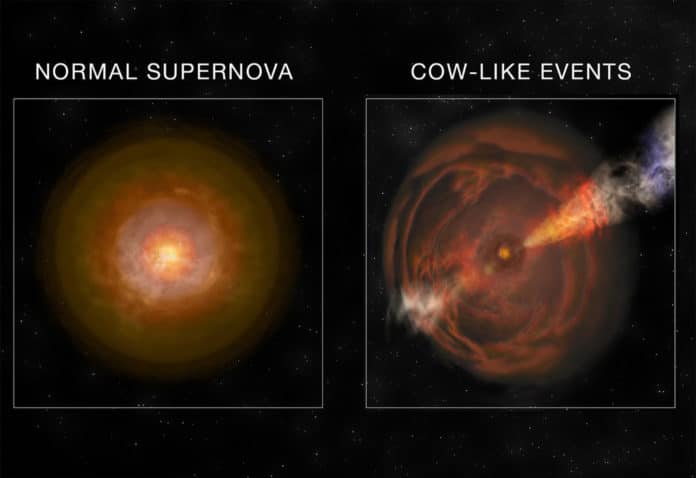In 2018, astronomers witnessed a stellar explosion that was ten times brighter in visible light than typical supernovae. That event has been named the AT2018cow, the first Cow event.
The event also emitted a large amount of highly variable X-rays. Hence, astronomers believed that they were directly witnessing the birth of a black hole or neutron star for the first time.
Another fact about the Cow- it emits lots of mass before exploding. This mass shines later after an explosion. When the stars explode, they produce shock waves that are thought to plunge through the pre-existing material, causing them to illuminate in radio and millimeter-frequency light.
Recently, astronomers discovered another member of the new “Cow” class of supernova explosions. This event has been named AT2020mrf.
Astronomers also offered evidence that either active black holes or neutron stars could be the source behind these unusual stellar explosions.
Yuan Yao (MS ’20), a graduate student at Caltech, said, “Cow-like events have at their cores very active, and most exposed, compact objects that emit high-energy X-ray emission.”
“We can see down into the heart of these explosions to directly witness the birth of black holes and neutron stars. The supernovae are not cloaked by material.”
Astronomers detected the AT2020mrf in X-rays rather than optical light. The event was originally spotted in July 2020 using X-ray data from the Russian–German Spektrum-Roentgen-Gamma (SRG) telescope. They checked observations taken in optical light by the Zwicky Transient Facility (ZTF), which operates from Caltech’s Palomar Observatory, and found that ZTF had also spotted the event.
The data uncovered that this explosion initially shined with 20 times more X-ray light than the original Cow event. Data captured one year later by NASA’s Chandra X-ray Observatory showed that the explosion was sizzling but shining with 200 times more X-ray light than that detected from the original Cow event.
Yao said, “When I saw the Chandra data, I didn’t believe the analysis at first. I reran the analysis several times. This is the brightest Cow supernova seen to date in X-rays.”
“The large amount of energy release and the fast X-ray variability seen in AT2020mrf provide strong evidence that the nature of the central engine is either a very active black hole or a rapidly spinning neutron star called a magnetar. In Cow-like events, we still don’t know why the central engine is so active, but it probably has something to do with the type of the progenitor star being different from normal explosions.”
“Because this event did not look exactly like the other four Cow-like events, this new class of supernovae is more diverse than originally thought. Finding more members of this class will help us narrow in on the source of their power.”
Journal Reference:
- Yuan Yao et al. The X-ray and Radio Loud Fast Blue Optical Transient AT2020mrf: Implications for an Emerging Class of Engine-Driven Massive Star Explosions. arXiv:2112.00751
